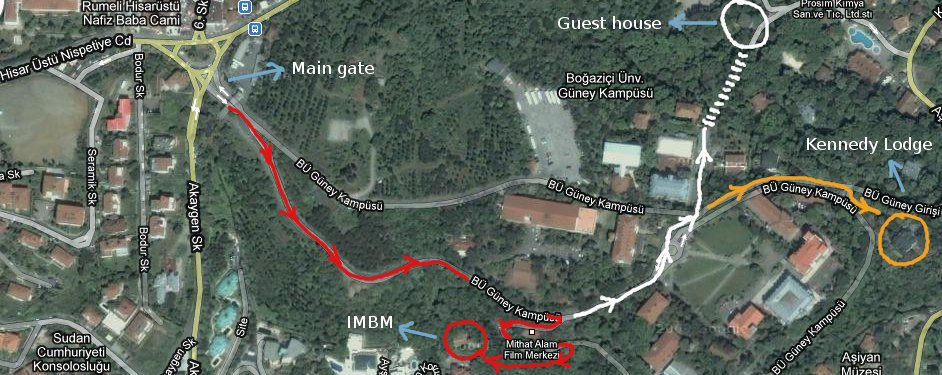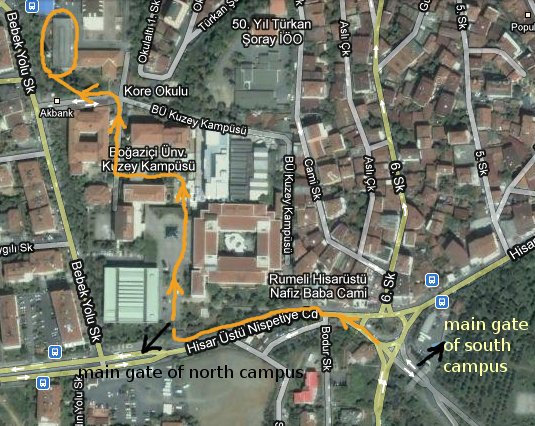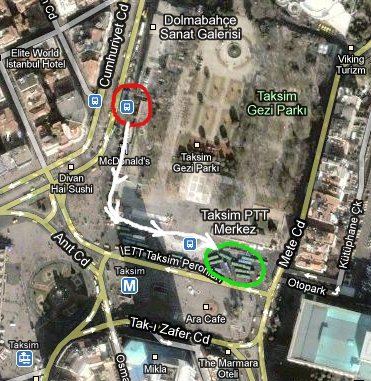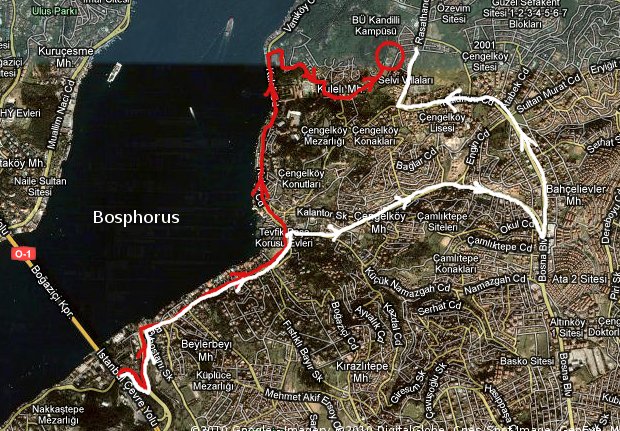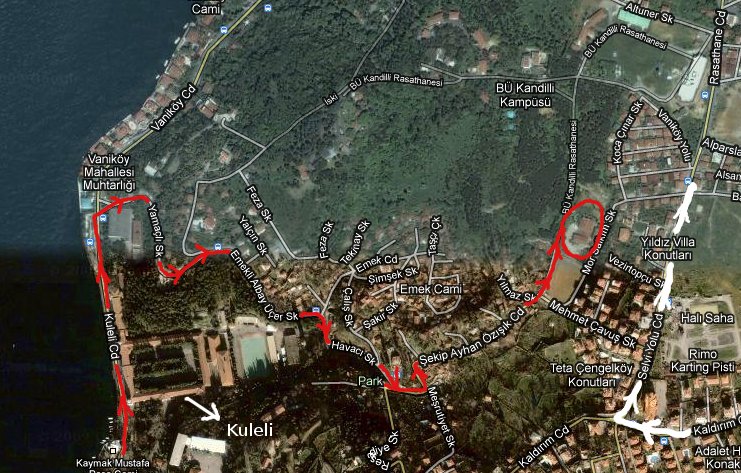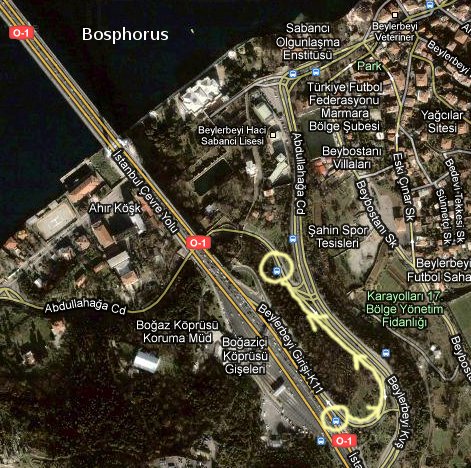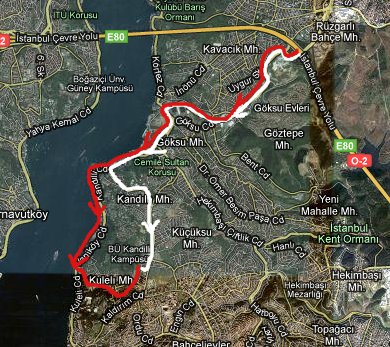|
İstanbul Contact Geometry and Topology Workshop
June 7 - June 10, 2010 İstanbul, |
|||||||
|
|||||||
|
The workshop is hosted by |
|||||||
|
The workshop is supported by Boğaziçi University, Tübitak Feza Gürsey Institute and Tübitak Project No: 107T896. The workshop organizers are Sinem Çelik Onaran, Ferit Öztürk. For more information send an e-mail to ferit.ozturk@boun.edu.tr or sinem.onaran@boun.edu.tr |
|||||||
|
List of Registered Participants
How to get to … (first read this) How to get to Kennedy Lodge and Guest house no:5 How to get to Boğaziçi University South Campus How to get to Feza Gürsey Institute
|
|||||||
|
OPENING TALK
David Gabai Volumes of hyperbolic 3-manifolds We outline a proof (with R. Meyerhoff and P. Milley)
that the Weeks manifold is the lowest volume closed orientable hyperbolic
3-manifold. Along the way we discuss a number of beautiful and simple ideas
needed to understand the topology and geometry of low dimensional manifolds.
MINI-COURSES
Kenneth Lee Baker Rational open books and contact structures The notion of an open book naturally generalizes to
the situation where the binding is rationally null homologous. These rational
open books support contact structures too. We will survey their behaviours
under the operations of Dehn surgery, cabling, and Hopf stabilization.
Vincent Colin Reeb vector field and open book decompositions In dimension 3, when a contact form \alpha is
adapted to an open book decomposition, the first return map of its Reeb vector field on a page gives a surface diffeomorphism h. The periodic orbits of the Reeb vector field then correspond to the binding curves
and the periodic points of h. We will explain how one can use the
dynamical properties of h to compute the cylindrical contact homology
of \alpha. We will treat a special case which turns out to be the
general one, when h is isotopic to a pseudo-Anosov
homeomorphism. This is a joint work with Ko Honda.
Hansjörg Geiges Contact structures on 5-manifolds
Paolo Ghiggini Tight contact structures on the Brieskorn spheres and contact invariants Classifying tight contact structures on Seifert
3-manifolds has been a respectable business for the last ten years, and a lot
of progress on this subject has been achieved thank to the effort of several
people. However a family of Seifert manifolds denoted by - \Sigma(2,3,6n-1)
has proved to be particularly stubborn, and its contact topology has been
completely understood only recently in a joint work of Jeremy Van Horn-Morris
and myself. In my lectures I will outline the classification of the tight
contact structures on - \Sigma(2,3,6n-1) and the main tool used in the
proof, namely Heegaard Floer
homology with twisted coefficients. I will also discuss the importance of
this family of three-manifold in the development of three-dimensional contact
topology.
Jeremy Van Horn-Morris Planar open books
and symplectic fillings
TALKS and SHORT TALKS
Elif Dalyan - Open Book Decompositions
of Links Quotient Singularities
Çağrı Karakurt - Ozsváth-Szabó Contact
Invariant and Stein Cobordisms
Elif Medetoğulları - A survey on classification of tight
contact structures on Seifert fibered 3-manifolds
David Shea
Vela Vick – Legendrian contact homology and nondestabilizability Chris Wendl
– On symplectic cobordisms between contact manifolds
|
|||||||
|
|
Monday |
Tuesday |
Wednesday |
Thursday |
|
||
|
9:00-9:30 |
Registration |
Lecture 1 - Baker |
Lecture 3 - Ghiggini |
Lecture 5 - Colin |
|||
|
9:30-10:30 |
Opening talk - Gabai |
||||||
|
11:00-12:30 |
Lecture 1 - Baker |
Lecture 2 - Geiges |
Lecture 4 - Van Horn-Morris |
Lecture 4 - Van Horn-Morris |
|||
|
12:30-14:30 |
Lunch |
Lunch |
Lunch |
Lunch |
|||
|
14:30-16:00 |
Lecture 2 - Geiges |
Lecture 3 - Ghiggini |
14:30-15:30 Wendl |
Lecture 5 - Colin |
|||
|
16:30-17:00 |
Short talk - Medetoğulları |
Short talk - Dalyan |
16:00-17:00 Karakurt |
Short talk - Vela-Vick |
|||
|
|
|||||||
|
|
|||||||
|
|
|||||||
|
Bahar Acu, METU |
Mustafa Korkmaz, METU |
||||||
|
Anar Akhmedov, |
Laurent La Fuente-Gravy, Université Libre
de Bruxelles |
||||||
|
Hülya Argüz, METU |
Ana García Lecuona, |
||||||
|
|
Daniel Mathews, Université de Nantes |
||||||
|
İnanç Baykur, |
Elif Medetoğulları, Atılım Üniversitesi |
||||||
|
Ahmet Beyaz, METU |
Hiraku Nozawa, ENS-Lyon |
||||||
|
Mohan Bhupal, METU |
Mehmetçik Pamuk, METU |
||||||
|
Barış Coşkunuzer, Koç Üniversitesi |
Julian Pook, Université Libre
de Bruxelles |
||||||
|
Elif Dalyan, Hitit Üniversitesi |
Anahita Eslami Rad,
Université Libre de Bruxelles |
||||||
|
Yvonne Deuster, Universität zu
Köln |
Nermin Salepci, Université de
Pau
|
||||||
|
Sinan Eden, Boğaziçi Üniversitesi |
Sheila (Margherita) Sandon, Université de
Nantes |
||||||
|
Tolga Etgü, Koç Üniversitesi |
Leili Shahriyari, |
||||||
|
Steven Frankel, Caltech |
Çağlar Uyanık, METU |
||||||
|
Marco Golla, |
Anne Vaugon, Université de Nantes |
||||||
|
Yusuf Gören, Boğaziçi Üniversitesi |
Sibel Sular, Balıkesir Üniversitesi |
||||||
|
Özgür İnce, |
David Shea Vela-Vick, |
||||||
|
|
Rafael Torres, Caltech |
||||||
|
Vladimir Krouglov, |
Chris Wendl, Humboldt-Universität zu |
||||||
|
Hee Jung Kim, Max-Planck Institute for Math |
Rumen Zarev, |
||||||
|
Mirko Klukas, Universität zu Köln |
Naïm Zénaïdi, Université Libre de Bruxelles |
||||||
|
|
|||||||
|
How to get to …
(first read this)
İstanbul is a very large city however it has an extensive public transportation network. The fare for transportation is low. Getting from one place to the other may take long. Do not get intimidated. Be patient. Depending on the route you choose, you will either take a metro, a Metrobüs, a bus, a Dolmuş, a HAVAŞ shuttle, a taxi or several of these. Here are some general tips: Divide the price
in liras by 2 to convert it to Euros and by 1,5 to convert to US Dollars.
You can pay the
fare on a bus. It costs normally 1,50-1,70 Liras (0,75-0,85 Euros) unless
otherwise stated below. You must buy a token for a metro and for a Metrobüs in advance which costs 1,50 Liras. You might by
an electronic card/ticket ELBİL which consists of 5 tickets and costs 7,50
Liras. You cannot buy an ELBİL on a bus.
Although there is
a transfer discount, that does not apply if you pay on the bus or if you use
an ELBİL.
Cabs are usually
trustworthy. Yet always make sure that the taxi driver turns the meter on.
The trip
durations given below are on the average. There might be drastic traffic
jams.
İstanbul Atatürk Airport (IST) and Boğaziçi University South Campus are on the European side of İstanbul.
IMBM, Kennedy
Lodge and Guest House No: 5 are in the South Campus.
|
|||||||
|
IMBM is situated in Boğaziçi
University South Campus. Follow the red path in Map.1 below to reach the Center from the main entrance of the South Campus. Map.1 |
|||||||
|
How to get to Kennedy Lodge and Guest House no:5
Both are in the
South Campus. Kennedy Lodge is marked with the orange circle while Guest
House no: 5 is marked with white circle in the Map.1 above. On the white path
there are stairs. You may ask your way to the gate keepers of the Campus.
This building is
situated in the North campus. Once you reach the main gate of the South
Campus, follow the orange route shown in the Map.2 below. You may ask your
way to the gate keepers of the North Campus. Tell that you are going to Üçüncü Yurt (pronounce Ütchündjü
Yurt, read all letters). Map.2
|
|||||||
|
How to get to Boğaziçi University South Campus
FROM THE İSTANBUL
1) HAVAŞ + BUS (convenient): Go out of the arrival hall. In front of the building take the shuttle called HAVAŞ to Taksim. It costs 10 liras (5 Euros). It takes around 30-45 minutes to reach Taksim, which is the last stop. Where you get off is shown in the Map.3 below with a red circle. Go to the green circle. Take the bus 559C which goes to Rumelihisarüstü. You can pay on the bus. A ticket costs 1,5 Liras. Tell the driver to drop you at the gate of the South Campus (say Ghünei Kampüs). It takes around 30 minutes to get there. Get off and use the campus map above. Map.3 |
|||||||
|
2) METRO + METROBÜS + BUS (fast, cheapest): Follow the METRO signs in the airport. This is the first stop of the metro. You must buy a token or an ELBİL of 5 tickets. Take the metro and get off at the third station, Ataköy-Şirinevler. This trip takes several minutes. Then change to Metrobüs. This is nothing but a bus on a dedicated track. Take number 34 going to Zincirlikuyu. You can pay on the bus. A ticket costs 1,5 Liras. Get off in Zincirlikuyu, the last stop. It takes around 40 minutes to get there. Follow the signs that reads Sarıyer. Up the stairs there are several bus stops. Take the bus 559C which goes to Rumelihisarüstü. Tell the driver to drop you at the gate of the South Campus (say Ghünei Kampüs). It takes around 15 minutes to get there. Get off and use the Map.1 of the South Campus above.
3) TAXI (easy, cheap if you are several people): Go out of the arrival hall. In front of the building take one of the (yellow) cabs. Tell the driver that you want to go to “Boazitchi Üniversitesi Ghünei Kampüs” (read all the letters). It takes around 45 minutes to get to the campus and costs 35-45 Liras (18-22 Euros).
FROM
1) BUS + TAXI: Go out of the arrival hall. In front of the building take the bus number E3. It reads Sabiha Gökçen Havalimanı-4. Levent Metro. You can pay on the bus. A ticket costs 4,5 Liras. You will get off at the last stop. The trip takes more than an hour and even more depending on the traffic. On the way you will pass across Bosphorus. As soon as you get off from the bus, use the underground passage to get across the street. At the other side take a (yellow) cab. Tell the driver to take you to “Boazitchi Üniversitesi Ghünei Kampüs” (read all the letters). It takes around 15 minutes to get to the campus and costs around 10 Liras (5 Euros).
2) HAVAŞ + TAXI: Go out of the arrival hall. In front of the building take the shuttle called HAVAŞ to Taksim. It costs 13 Liras (6,5 Euros). Get off at Kavacık. The trip takes nearly an hour and even more depending on the traffic. As soon as you get off, take a (yellow) cab which will go in the same direction as the shuttle and eventually pass across Bosphorus. Tell the driver to take you to “Boazitchi Üniversitesi Ghünei Kampüs” (read all the letters). It takes around 15 minutes to get to the campus and costs around 15 Liras (7,5 Euros). How to get to Feza Gürsey Institute
FROM THE
1) METRO + METROBÜS + TAXI (fastest): Follow the METRO signs in the airport. This is the first stop of the metro. You must buy a token (1,5 Liras) or an ELBİL. Take the metro and get off at the third station, Ataköy-Şirinevler. This trip takes several minutes. Then change to Metrobüs. This is nothing but a bus on a dedicated track. Take number 34 going to Zincirlikuyu. You can pay on the bus. A ticket costs 1,5 Liras. Get off in Edirnekapı or at some further stop. On the same platform take number 34A going in the same direction. You will not pay again. Get off at the stop Boğazköprüsü; this is the first stop on the Asian side after Bosphorus. The trip with the metrobüs takes around one hour. Leave the highway by taking the stairs to the lower road. Take a (yellow) cab. Tell the driver to take you to “Feza Ghürsei Enstitüsü” at “Kandilli Rasathanesi” (read all the letters). It takes around 15 minutes to get there. Normally the cab should follow the red route in the Map.4 and Map.5 below. It goes for a while along Bosphorus and then takes the road uphill just after Kuleli. The Map.5 shows the portion of the route from Kuleli to the Institute enlarged. The trip with the cab takes around 20 minutes and costs like 10 Liras (5 Euros). Map.4 Map.5
2) METRO + METROBÜS + BUS or DOLMUŞ (fast, cheap): Follow the METRO signs in the airport. This is the first stop of the metro. You must buy a token (1,5 liras) or an ELBİL. Take the metro and get off at the third station, Ataköy-Şirinevler. This trip takes several minutes. Then change to Metrobüs. This is nothing but a bus on a dedicated track. Take number 34 going to Zincirlikuyu. You can pay on the bus. A ticket costs 1,5 Liras. Get off in Edirnekapı or at some further stop. On the same platform take number 34A going in the same direction. You will not pay again. Get off at the stop Boğazköprüsü; this is the first stop on the Asian side after Bosphorus. The trip with the metrobüs takes around one hour. Leave the highway by taking the stairs to the lower road. Follow the white path in the Map.6 below to get to the bus stop marked. At that stop take a bus or a dolmuş. The bus number is 15R and reads Üsküdar-Rasathane. A ticket costs 1,5 Liras. Dolmuş is a small bus (one third of a bus) for 14 people seated. The fare is around 1,5 Liras. In both cases, tell the driver to drop you near “Feza Ghürsei Enstitüsü” next to “Kandilli Rasathanesi” (read all the letters). It takes around 25 minutes to get there. Both the bus and the dolmuş follow the white route in the Map.4 and Map.5 above. The end of the white route is the bus stop. The Map.5 shows the last portion of the route enlarged. The driver can tell you which direction to go as soon as you get off. You have to get across the street and go downhill. Ask to local people where “Feza Ghürsei” is or use the local map at http://www.gursey.gov.tr/visit.php?m=visit#institute. Map.6
3) TAXI (expensive): Go out of the arrival hall. In front of the building take one of the (yellow) cabs. Tell the driver that you want to go to the Asian side, to “Feza Ghürsei Enstitüsü” near “Kandilli Rasathanesi” (read all the letters). It takes more than an hour and costs more than 50 Liras (25 Euros). The cab is going to pass across the Bosphorus. Hence they may charge more than it has to be. Besides, the distance is a lot and they might take the liberty to make it longer by choosing this or that bridge. It might cost up to 70 Liras. A little bit chaotic.
FROM
1) BUS + TAXI: Go out of the arrival hall. In front of the building take the bus number E3. It reads Sabiha Gökçen Havalimanı-4. Levent Metro. You can pay on the bus. A ticket costs 4,5 liras. Get off at Kavacık. The trip takes nearly an hour or even more depending on the traffic. As soon as you get off, take a (yellow) cab. Tell the driver to take you to “Feza Ghürsei Enstitüsü” near “Kandilli Rasathanesi” (read all the letters). The cab should turn immediately right and pass over and across the highway to the other side and go downhill, leaving the highway behind. It takes more or less 20 minutes to get to the institute and costs around 20 Liras (10 Euros). Normally the cab should follow either the red route or the white one in the Map.7 below. The red one is shorter.
2) HAVAŞ + TAXI: Go out of the arrival hall. In front of the building take the shuttle called HAVAŞ to Taksim. It costs 13 Liras (6,5 Euros). Get off at Kavacık. The trip takes nearly an hour or even more depending on the traffic. As soon as you get off, take a (yellow) cab. Tell the driver to take you to “Feza Ghürsei Enstitüsü” near “Kandilli Rasathanesi” (read all the letters). The cab should turn immediately right and pass over and across the highway to the other side and go downhill, leaving the highway behind. It takes more or less 20 minutes to get to the institute and costs around 20 Liras (10 Euros). Normally the cab should follow either the red route or the white one in the Map.7 below. The white one is shorter. Map.7
|
|||||||
